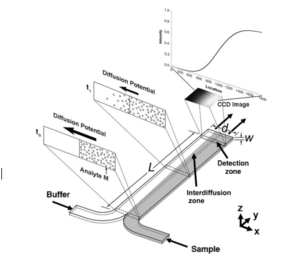Diffusion - Daniel Kallin

Background
Due to the low Reynolds number of fluids on the microscale, diffusion is one of the most important transport mechanisms. Although diffusion limited transport poses challenges for mixing, it can be very beneficial for separations [1]. As the scale of operation decreases in size, the efficacy of diffusion as a transport mechanism increases. For example, a small bacterium sized particle with a diameter of 0.5 μm takes 200 seconds to travel 10 μm by diffusion, opposed to a smaller molecule with a molecular weight of 330 which would take only 0.2 seconds to travel that same distance [2]. This makes it clear that diffusion is a viable method for transport in microfluidic devices.
Methods
T-sensor

The T-sensor is an accurate way to examine the diffusion of two fluids into each other. Two fluids are flowed into the same channel at the same rate, and imaging techniques are used to view diffusion gradients. The more viscous fluid occupies a greater fraction of the channel containing two fluids as demonstrated by the equation νA/νB ≈ µA/µB, where µi is the viscosity of species i, and νi is the fraction of the channel occupied by i.[3] Although T-sensors are widely used to study the diffusive properties of fluids, they are rarely used to separate fluids.
H filter
The H-filter is similar to the T-sensor, but instead of imaging fluids, is can be used to separate fluids. It is essentially a T-sensor in which the combined fluid channel splits into two channels. The H-filter uses the principle that larger molecules diffuse at a slower rate than small molecules[4]. Separation of the two species depends on the diffusion coefficients of each species, the contact time, which is a function of length and fluid flowrate, and the dimensions of the channel [5].

Advantages
While many separation techniques require reaction components, or induced electrical fields, diffusion does not; it simply takes advantage of the natural flow properties of the fluids entering a device. This has several advantages over other separation techniques. It is significantly less expensive to make microfluidic devices that do not require reaction components that have to be anchored to a solid support, or electrical components, such as batteries. In addition, the lack of chemical, electrical, and mechanical agitation allow the conditions to mimic that of a cell, which is important for biological analysis and potential microfluidic medical devices. Similarly, diffusion allows for direct analysis of complex samples without prior separation, which often times can interfere with components such as blood cells.
Reference
1. Hatch, A., Garcia, E., & Yager, P. (2004). Diffusion-Based Analysis of Molecular Interactions in Microfluidic Devices. Proceedings of the IEEE, 92(1), 126-139. http://doi:10.1109/jproc.2003.820547
2. Weigl B H, Yager P. "Microfluidic Diffusion-Based Separation and Detection." Science 15 Jan 1999: Vol. 283, Issue 5400, 346-347 http://10.1126/science.283.5400.346
3. Kamholz, A. E., Weigl, B. H., Finlayson, B. A., & Yager, P. (1999). Quantitative Analysis of Molecular Interaction in a Microfluidic Channel: The T-Sensor. Analytical Chemistry, 71(23), 5340-5347. http://doi:10.1021/ac990504j
4.Brody, J. P., & Yager, P. (1997). Diffusion-based extraction in a microfabricated device. Sensors and Actuators A: Physical, 58(1), 13-18. http://10.1016/s0924-4247(97)80219-1
5. Osborn, J. L., Lutz, B., Fu, E., Kauffman, P., Stevens, D. Y., & Yager, P. (2010). Microfluidics without pumps: reinventing the T-sensor and H-filter in paper networks. Lab on a Chip, 10(20), 2659-2665. http://10.1039/c004821f
